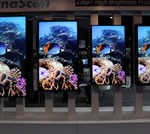
The cost of content for digital signage has been known to elicit a generous helping of expletives from campus technologists who, before making their signage purchases, didn’t peek at the price tag of the moving pictures that fill the screens on their shiny new signs.
Digital signs are strategically placed at the entrances of lecture halls and in the middle of student unions, screens ready to serve as the college’s next-generation bulletin board. But as many college and university IT decision makers have found out in recent years–as digital signs have become commonplace in higher education–filling the screen with more than the occasional announcement can be a pricey prospect.
The rights to an advertisement that can scroll across the screen between campus-related announcements can cost more than $5,000, signage industry experts said in interviews with eCampus News. Even tweaking an ad–shrinking it, or changing its color or sound–can cost $2,000.
Read more about digital signage in higher education…
How to engage a higher education audience beyond the digital screen
Without improved content, digital signage could ‘ride off into the sunset’
“There’s this mentality out there that if we build it, they will come,” said Kim Sarubbi, president of Beverly Hills-based Saddle Ranch Digital, a digital content company that sells the images and videos usually used on a rotating basis. “But no one will care that a digital sign is there if there’s no content. … The stuff that’s actually going to be on the screen is the most important part of the whole equation.”
The steep costs of pictures and video to fill 24 hours of screen time and make each digital sign relevant to the campus community sometimes catches college IT staff off guard after they’ve made the case to spend tens or hundreds of thousands on the screens alone.
“[Colleges] want to put up digital signage and think that it magically takes care of itself, when really, putting it out and turning it on is the easy part,” said Perry Goldstein, a veteran in the consumer electronics industry and a marketing manager for Marshall Electronics in California. “And if you don’t have the right amount and the right kind of content, you risk students ignoring the signs. Then the signs just become part of the background. They become furniture.”
The list of people who must be compensated before content can be aired on a campus’s digital screen reads like a short laundry list: Directors, actors, voice-over professionals, photographers, writers, and companies that produce material for digital signage.
Even if a college or university goes a cheaper route and buys canned shots from a digital signage content library, each shot could cost more than $100, adding up to thousands once a school has enough images to keep the screen fresh in between severe weather warnings, campus security alerts, and everyday announcements like lunch menus, upcoming concerts, and parking lot closures.
“I don’t think people understand what they’re getting into,” Goldstein said. “It’s kind of like getting a puppy for Christmas. A 12-year-old doesn’t understand the concept of having to take the puppy to the vet, feed it, walk it, take care of it. … This is a long-term commitment that some [in higher education] don’t completely understand.”
Skimping on digital content, Sarubbi said, could be just as risky as having a blank digital screen for part of the school day. Without visuals and sound that match those in TV shows and commercials, students are likely to tune out the signs, no matter how unavoidable on their walks to and from class.
“People expect signage content to be great because our TVs are such great quality,” she said. “We’re used to high definition. We’re used to great sound quality, and we don’t necessarily care if the sign is brand name or not. People care most about content.”
Goldstein said the importance of digital signage content would be better understood by campus technologists as signage purchases become more common in higher education.
“There just can’t be a very high tolerance for sub-par content on anyone’s signage,” he said. “I think people will get that concept.”
More than 2,200 academic sites added digital signage to their campuses in 2011, according to Northern Sky Research, a market research and consulting firm based in Massachusetts.
About 1,500 campuses added digital signage in 2010, and more than 8,400 digital signage screens were installed on North American educational sites last year.
That number is expected to grow beyond 13,000 screens in 2011, according to Northern Sky Research.
Higher-education officials could have even more insight into campus use of digital signage networks this fall, when the Platt Retail Institute (PRI)—a leading researcher of digital communication tools—will study digital signage on as many as 20 campuses nationwide after the company’s research showed that 97 percent of college students prefer digital communication to the traditional paper or static signs.
- Research: Social media has negative impact on academic performance - April 2, 2020
- Number 1: Social media has negative impact on academic performance - December 31, 2014
- 6 reasons campus networks must change - September 30, 2014

Comments are closed.